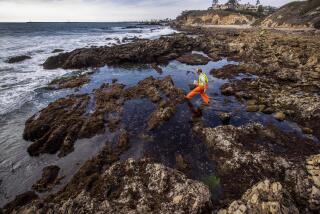Gulf currents aided breakdown of oil after BP spill, study says
The geography and water circulation patterns of the northern Gulf of Mexico promoted the breakdown of oil and gas spewing from a busted wellhead during the BP oil disaster, according to a new study.
Using computer models and Navy data on gulf currents, the authors concluded that rather than moving away from the deep-sea wellhead in a linear fashion, oil-laced water often looped back, returning hydrocarbon-munching bacterial blooms to the rising oil plume for repeated feasts.
“That northern portion of the gulf is almost enclosed on three sides,” said lead author David Valentine, a UC Santa Barbara professor of microbial geochemistry. “So it’s subject to a lot of more subtle forces that will slosh the water around like a washing machine in a circle.”
The recirculation meant the natural gas and oil escaping from nearly a mile below the ocean surface was consumed more quickly than would have otherwise been the case.
The looping currents “came back over the wellhead and got a second and perhaps a third introduction of oil and gas. And when that happened there was a [bacterial] community that had grown up in the intervening time” and was ready to consume more hydrocarbons.
The paper, published in the Proceedings of the National Academy of Sciences, is part of the growing body of work analyzing the fate and effects of the country’s largest offshore oil spill.
After the Deepwater Horizon rig exploded off the Louisiana coast in April 2010, oil and methane belched for months from the wellhead and pipes lying on the sea floor. Some rose to the surface, where it was burned or scooped up, or made its way to the Louisiana coast. Some sank to the bottom, where it was buried in sediments.
But much of it seemed to disappear, dispersing in the water column or providing an all-you-can-eat buffet for microbes that live off the gulf’s natural oil seeps.
Valentine, who worked with UCSB mechanical engineering professor Igor Mezic and others on the study, said the modeling could be a template for research during other deep-sea drilling projects.
Terry Hazen, a scientist at the Oak Ridge National Laboratory who has also studied the BP spill, said Valentine’s work could explain why sampling didn’t reveal the expected level of hydrocarbons in waters some distance from the wellhead. “We didn’t know that there was this [circulation] loop. That changes how fast things were degrading.”
But Ian MacDonald, a Florida State University oceanography professor who has also published research on the spill, said he was “a little skeptical of the huge bacterial response.”
“The problem that I have generally with this water column work is that the data that were collected of bacteria in the water column were pretty few.... The challenge that we scientists are going to have forever is explaining a phenomenon that we didn’t really measure very well.”
More to Read
Start your day right
Sign up for Essential California for news, features and recommendations from the L.A. Times and beyond in your inbox six days a week.
You may occasionally receive promotional content from the Los Angeles Times.







